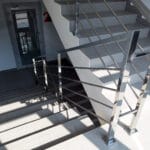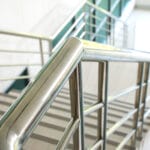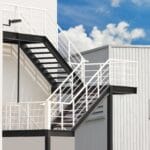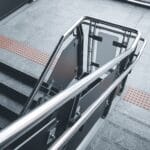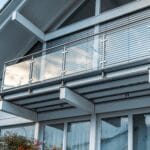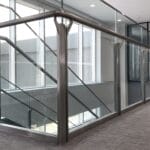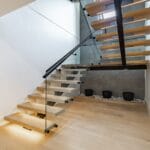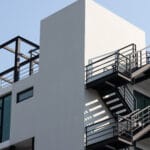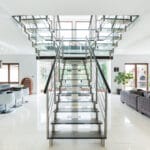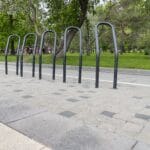Floating stairs, also called suspended stairs, have become a must-have interior design element in modern projects. They feature treads that seem to float in the air with no visible support, creating a striking visual effect and an impression of lightness. This type of staircase is generally fixed to an exterior stringer or directly to the wall, resulting in a self-supporting structure that frees up floor space and becomes an architectural focal point.
This design highlights spatial fluidity and encourages light circulation, which is especially appreciated in contemporary interiors. Beyond aesthetics, floating stairs require precise engineering and a careful choice of materials to ensure safety, user comfort, and long-term durability.
Key takeaways
- Floating stairs create a unique, highly designed visual effect.
- Standards for width, depth, and the presence of a handrail are essential to ensure safety.
- Materials influence durability, maintenance, and style.
- Their higher cost is explained by custom design and specialized engineering.
- Professional installation is essential for stability and compliance.
- Regular maintenance extends lifespan and preserves aesthetics.
Essential safety standards
The importance of regulations
Safety is an absolute priority when designing and installing a floating staircase. Standards require a handrail for any staircase with more than three risers. The minimum width must be 86 cm (34 in), while tread depth should be between 23.5 cm and 35.5 cm (9.5 to 14 in).
These dimensions not only ensure comfortable circulation but also reduce the risk of falls, even in high-traffic environments. Adhering to standards also avoids compliance issues during resale or a safety inspection.
Why a handrail is mandatory
A handrail provides a stable, reassuring support for users, reducing risks related to loss of balance. In a floating staircase, it can become a major visual element, playing with material contrasts (glass and stainless steel, wood and steel) to accentuate the overall style. A well-integrated handrail doesn’t compromise the staircase’s minimalist look and can even reinforce its architectural impact.
Materials used for floating stairs
Material choice influences the staircase’s appearance, durability, comfort, and maintenance. Some materials convey warmth, others an industrial or minimalist touch. Common options include wood, glass, metal, stone, and composites, each behaving differently with wear, impacts, and climatic variations.
| Material | Advantages | Points to watch | Aesthetics |
| Wood | Warmth, natural charm, adaptable to different styles | Regular maintenance, sensitivity to humidity | Classic and timeless |
| Glass | Brightness, modernity, airy effect | Frequent cleaning, scratch risk | Minimalist and elegant |
| Metal | Strength, longevity, industrial style | Scratch-sensitive depending on finish | Contemporary and robust |
| Stone | High resistance, durability | Significant weight, higher cost | Noble and substantial |
| Composites | Weather resistance, low maintenance | Less authentic look than natural materials | Varies by composition |
Wood
Much appreciated for its warmth and versatility, it fits just as well in modern as in traditional interiors. Finishes (stains, varnishes, paints) allow it to match different styles. However, in a floating staircase, wood stability must be ensured with specific treatments to limit warping or cracking.
Glass
Ideal for maximizing light, it gives an impression of lightness and openness. In a floating staircase, it can be used for treads or guardrails, bringing transparency and modernity. It does, however, require careful, regular maintenance to keep its clarity, especially in high-traffic areas.
Metal, stone, and composites
Metal is prized for its contemporary style and strength, often offering brushed or painted finishes. Stone conveys a sense of robustness and luxury, but its weight demands a reinforced supporting structure. Composites, for their part, combine lightness, strength, and low maintenance, while offering a wide range of finishes.
Cost and installation
Why it costs more
Floating stairs represent a higher investment than traditional models because of:
- High-end materials chosen for their durability and visual appeal
- Custom fabrication tailored to the client’s space and style
- Advanced engineering needed to ensure stability and compliance with standards
Added to this is the increased labour time linked to precise cuts and adjustments. While the initial investment is higher, the aesthetic added value and longevity often offset the extra cost.
The need for professional installation
Implementation requires precise structural calculations and mastered assembly techniques. Invisible anchors, even load distribution, and strict respect for tolerances leave no room for error. Hiring a qualified professional ensures not only installation safety but also a flawless finish that showcases the staircase’s unique character.
Styles and configurations
Floating stairs can take several configurations depending on space and the desired effect:
- Single stringer: a single central support for a minimalist, airy look, often used in clean, pared-back interiors.
- Double stringer: two lateral supports offering a more substantial appearance and a stronger impression of stability.
- Spiral: ideal for optimizing space and delivering a spectacular visual effect.
Invisible anchors are achieved with pins, mortared embedding, or a clad side stringer. These solutions hide any visible structure and fully showcase the treads, heightening the “floating” effect.
Stability and safety
Stability relies on precise technical parameters:
- Maximum tread length: 90 cm (35 in)
- Minimum thickness: 6 cm (2 1/3 in)
These dimensions ensure the tread can support weight and stresses without excessive deflection. Load calculations must be carried out in advance to determine optimal anchoring and material selection. Visual safety also plays a role: even if the structure is solid, a guardrail or transparent elements can reassure users.
Care and maintenance
Maintenance by material
- Glass: use non-abrasive cleaners and a microfibre cloth; avoid any metal object that could scratch the surface.
- Wood: apply a protective treatment regularly; check for cracks or splinters.
- Metal: clean with soapy water; periodically inspect for any marks or deep scratches.
Signs it’s time to refurbish
A moving tread, signs of corrosion, or structural sagging are all indicators that intervention is required. Acting quickly prevents more extensive repairs and preserves user safety.
Advantages over traditional staircases
Floating stairs offer:
- A unique design that immediately draws the eye
- An increased sense of space thanks to the absence of risers and visible supports
- An adaptability to modern, industrial, or minimalist styles
- A boost to property value, thanks to their high-end, customized character
They are also visually lighter, which helps avoid overwhelming already compact spaces.
Integration into interior design
Floating stairs fit seamlessly into contemporary interiors but can also create an elegant contrast in a more classic setting. Their open structure preserves natural light and allows for glass or stainless steel guardrails for an even more refined result. By playing with finishes and materials, it’s possible to create a staircase perfectly harmonized with the rest of the architecture.
Conclusion
Floating stairs represent a successful marriage of bold design, precise engineering, and functionality. They bring elegance and modernity to an interior while remaining compliant with safety standards; provided they are designed and installed by qualified professionals. Their higher cost is justified by the durability, originality, and aesthetic value they offer. If you’re considering a floating staircase that combines technical performance with visual refinement, Metanox can put its expertise to work to design and build a custom, safe staircase that integrates perfectly into your space.
